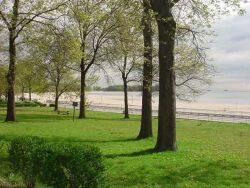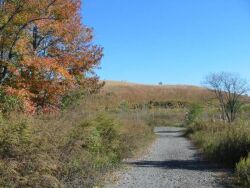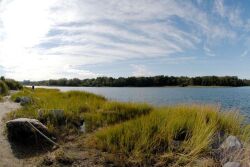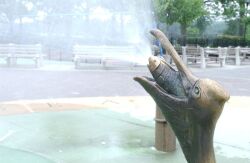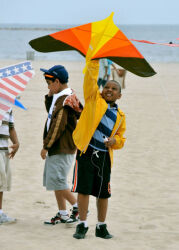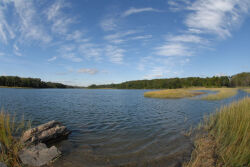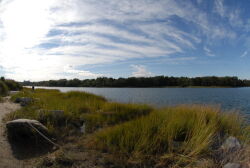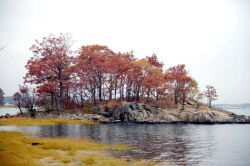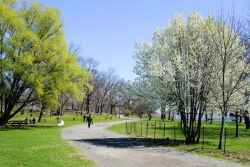Pelham Bay Park
The Daily Plant : Tuesday, July 13, 2004
DON’T GO POSTAL—GO COASTAL!

New York City is steamy in summer, but Parks & Recreation’s 14 miles of public beaches, situated on the City’s 578-mile coastline, are free, open to all, and just a bus or subway ride away. They can be found in every borough except river-bound Manhattan, and offer every flavor from Coney Island, the quintessential waterfront amusement park, to Orchard Beach, the "Bronx Riviera."
The Arsenal Gallery’s newest exhibit, Going Coastal: The Beaches of New York City, offers viewers a look at the history and development of the City’s beaches. The exhibition features 92 archival and contemporary photographs, vintage postcards, historic renderings, as well as artifacts and memorabilia representing the vital role that beaches play in the life of the city.
Until the 19th century, the Long Island Sound and Atlantic shorelines were pristine, rugged, and hard to get to. But in the 1820’s, the first developments sprang up, beginning a long tug-of-war between private and public control of what was to become an increasingly valued resource. After the Civil War, the pace of development accelerated with the opening of fashionable resorts like the Manhattan Beach and Oriental Hotels at Coney Island. Sections of the wild dunes of the Rockaway peninsula in Queens and Staten Island’s South Shore were also converted for recreation. By century’s end, with the help of improved rail and ferry transportation, a thriving amusement-park culture was serving the city’s skyrocketing population.
By the late 1920’s, the City had established Jacob Riis Park, the Coney Island boardwalk, and a few small waterfront parks in Brooklyn and Queens that catered mainly to day-trippers. But most of the shoreline was claimed and managed by entrepreneurs, whose taste often ran to the tawdry. At Wolfe’s Pond Park on Staten Island, and in portions of the Rockaways and Pelham Bay Park in the Bronx, large and sometimes illegal bungalow communities took root.
When he became Parks Commissioner in 1934, Robert Moses set out to expand and make the beaches more wholesome. He emphasized the need for an orderly, healthful, and safe experience, which required razing the offending bungalows and kicking out poorly-run concessions, plagued by corruption. Before the Parks Department gained full jurisdiction of the beaches in 1938, he commented, "No inland lake, stream or pool can compete with the Ocean and its tributaries which surround the City." Vast improvements followed. In the Bronx, the water between Rodman’s Neck and Hunter Island was filled to create Orchard Beach’s wide crescent. New boardwalks went up at South and Midland Beaches, Coney Island, Rockaway, and Jacob Riis Parks. Public works like the Belt Parkway and the Marine Parkway Bridge improved beach access.
Moses was a victim of his success. Postwar beach attendance soared, and in response the City aggressively acquired coastland, including Manhattan Beach. By the time Moses left office in 1960, public beaches had increased from 1 to 17.96 miles. His successors have faced operational hurdles of almost biblical proportions as they have combated storms, fires, medical waste, and ordinary litter. In 1974, during the fiscal crisis, Riis Park in Queens and Great Kills on Staten Island were transferred along with Jamaica Bay from City to Federal jurisdiction as the Gateway National Recreation Area.
Now the increasingly post-industrial city has turned its attention again to its waterfront, an emphasis that has led to many public and private beach projects. At Orchard Beach, $3.3 million was invested in 1998 to rebuild the monumental bathing pavilions and terraces. At Midland Beach on Staten Island, an enormous capital investment has paid for boardwalk repair, a grand entrance plaza (2002), and a new fishing pier (2003). At Rockaway Beach, the City broke ground in 2004 for a new oceanside skate park, while Coney Island gained new comfort stations, information kiosks, music pavilions, and KeySpan Park (2001), home of the Brooklyn Cyclones. These amenities will help the 12 million visitors to the city’s beaches cool off and enjoy themselves, ensuring that New Yorkers continue to go coastal well into the 21st century.
Most of the images on display are from the New York City Parks & Recreation Photo Archive and Map File Collections. Images are also on loan from the Municipal Archives, and vintage postcards were generously loaned from the Staten Island Institute of Arts & Sciences. The exhibition is curated by Parks & Recreation’s Director of Art & Antiquities Jonathan Kuhn, with assistance from Public Art Coordinator Patricia Hamilton. Additional images or "outtakes" can be found in a virtual gallery presented on Parks & Recreation’s website at www.nyc.gov/parks.
QUOTATION FOR THE DAY
"I shut my eyes and all the world drops dead; I lift my eyes and all is born again."
Sylvia Plath
Poet (1932-1963)
Check out your park's Vital Signs
Clean & Safe
Green & Resilient
Empowered & Engaged Users
Share your feedback or learn more about how this park is part of a
Vital Park System

Know Before You Go

Contacts
Pelham Bay Park Administrator's Office: (718) 430-1891
Bartow-Pell Mansion Museum: (718) 885-1461
Park Enforcement Patrol: (718) 430-1815
Pelham Bay & Split Rock Golf Course: (718) 885-1258
Turtle Cove Driving Range: (718) 885-2646
Orchard Beach Nature Center: (718) 885-3466
Urban Park Rangers: (718) 548-0912
Events and General Parks Information: 311
Bronx Equestrian Center: (718) 885-0551
Friends of Pelham Bay Park: (718) 430-4685
Bronx Recreation: General Information: (718) 430-1825
Bronx Recreation: Special Events Permits: (718) 430-1848
Bronx Recreation: Sports Permits: (718) 430-1840
Bronx Recreation: Tennis Permits: (718) 430-1848



